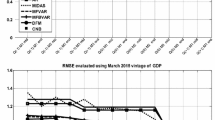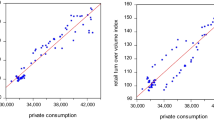Abstract
In this paper, we reassess the forecasting performance of the Bayesian mixed-frequency model suggested in Carriero et al. (2015) in terms of point and density forecasts of the GDP growth rate using US macroeconomic data. Following Chauvet and Potter (2013), we evaluate the forecasting accuracy of the model relative to a univariate AR(2) model separately for expansions and recessions, as defined by the NBER business cycle chronology, rather than relying on a comparison of forecast accuracy over the whole forecast sample spanning 1985Q1–2011Q3. We find that most of the evidence favouring the more sophisticated model over the simple benchmark model is due to relatively few observations during recessions, especially those during the Great Recession. In contrast, during expansions, the gains in forecasting accuracy over the benchmark model are at best very modest. This implies that the relative forecasting performance of the models varies with business cycle phases. Ignoring this fact results in a distorted picture, the relative performance of the more sophisticated model in comparison with the naive benchmark model tends to be overstated during expansions and understated during recessions.







Similar content being viewed by others
Notes
We distinguish between plain and crisscrossed cells both coloured in grey. The description of the crisscrossed cells is provided in Sect. 3.3 below.
In the case of monthly quarterly data, p equals three, such that the number of regressors effectively triples.
Observe that at each forecast origin, lagged values of the dependent variable, \(y_{t-i}\), belong to different GDP data vintages. For the sake of notational simplicity we have suppressed this notation.
Recall from Eq. (6) that the log score are computed as the negative (logarithmic) value of the predictive density at the realised outturn value, i.e. the intersection of the vertical black line with the blue and red lines for models with constant and stochastic volatility, respectively.
References
Carriero, A, Clark TE, Marcellino M (2013) Real-time nowcasting with a Bayesian mixed frequency model with stochastic volatility. Working Paper 9312, Centre for Economic policy Research, London
Carriero A, Clark TE, Marcellino M (2015) Realtime nowcasting with a Bayesian mixed frequency model with stochastic volatility. J Royal Stat Soc Ser A 178(4):837–862
Chan JCC (2017) The stochastic volatility in mean model with time-varying parameters: an application to inflation modeling. J Bus Econ Stat 35(1):17–28
Chauvet M, Potter S (2013) Forecasting output. In: Elliott G, Timmermann A (eds) Handbook of forecasting, vol 2. North Holland, Amsterdam, pp 1–56
Clark TE (2011) Real-time density forecasts from Bayesian vector autoregressions with stochastic volatility. J Bus Econ Stat 29(3):327–341
Croushore D, Stark T (2001) A real-time data set for macroeconomists. J Econ 105(1):111–130
Croushore D, Stark T (2003) A real-time data set for macroeconomists: does the data vintage matter? Rev Econ Stat 85(3):605–617
Edge RM, Kiley MT, Laforte J-P (2010) A comparison of forecast performance between federal reserve staff forecasts, simple reduced-form models, and a DSGE model. J Appl Econ 25(4):720–754
Foroni C, Marcellino M (2013) A survey of econometric methods for mixed-frequency data. Working Paper 2013/06, Norges Bank
Foroni C, Marcellino M, Schumacher C (2015) Unrestricted mixed data sampling (MIDAS): MIDAS regressions with unrestricted lag polynomials. J Royal Stat Soc Ser A 178(1):57–82
Geweke J, Amisano G (2010) Comparing and evaluating bayesian predictive distributions of asset returns. Int J Forecast 26(2):216–230 Special Issue: Bayesian Forecasting in Economics
Ghysels E, Santa-Clara P, Valkanov R (2004) The MIDAS touch: Mixed data sampling regression models. CIRANO Working Papers 2004s-20, CIRANO
Ghysels E, Sinko A, Valkanov R (2007) MIDAS regressions: further results and new directions. Econ Rev 26(1):53–90
Giannone D, Monti F, Reichlin L (2016) Exploiting the monthly data flow in structural forecasting. J Monet Econ 84:201–215
Gneiting T, Katzfuss M (2014) Probabilistic forecasting. Annu Rev Stat Appl 1(1):125–151
Guérin P, Marcellino M (2013) Markov-switching MIDAS models. J Bus Econ Stat 31(1):45–56
Kim HH, Swanson NR (2018) Mining big data using parsimonious factor, machine learning, variable selection and shrinkage methods. Int J Forecast 34(2):339–354
Marcellino M, Porqueddu M, Venditti F (2016) Short-term GDP forecasting with a mixed-frequency dynamic factor model with stochastic volatility. J Bus Econ Stat 34(1):118–127
Marcellino M, Schumacher C (2010) Factor MIDAS for nowcasting and forecasting with ragged-edge data: a model comparison for German GDP. Oxford Bull Econ Stat 72(4):518–550
Mazzi GL, Mitchell J, Montana G (2014) Density nowcasts and model combination: nowcasting Euro-Area GDP growth over the 2008–09 recession. Oxford Bull Econ Stat 76(2):233–256
McCracken MW, Owyang MT, Sekhposyan T (2015) Real-Time Forecasting with a Large, Mixed Frequency, Bayesian VAR. Working Papers 2015-30, Federal Reserve Bank of St. Louis
Mikosch H, Neuwirth S (2015) Real-Time Forecasting with a MIDAS VAR. KOF Working papers 15-377, KOF Swiss Economic Institute, ETH Zurich
R Development Core Team (2008) R: a language and environment for statistical computing. R Foundation for Statistical Computing, Vienna
Schorfheide F, Song D (2015) Real-time forecasting with a mixed-frequency VAR. J Bus Econ Stat 33(3):366–380
Siliverstovs B (2017) Short-term forecasting with mixed-frequency data: a MIDASSO approach. Appl Econ 49(13):1326–1343
Welch I, Goyal A (2008) A comprehensive look at the empirical performance of equity premium prediction. Rev Financial Stud 21(4):1455–1508
Zhang B, Chan J, Cross J (2018) Stochastic Volatility Models with ARMA Innovations: An Application to G7 Inflation Forecasts. CAMA working paper no. 32/2018
Author information
Authors and Affiliations
Corresponding author
Additional information
Publisher's Note
Springer Nature remains neutral with regard to jurisdictional claims in published maps and institutional affiliations.
The paper has benefited from comments made by Niklas Ahlgren, the editor, two anonymous referees and participants of a research seminar held at the Department of Economics and Finance, the Tallinn University of Technology (Estonia), by participants of the 18th IWH-CIREQ-GW Macroeconometric Workshop: Mixed-Frequency Data in Macroeconomics and Finance (Halle, Germany), the 22nd Annual International Conference on Macroeconomic Analysis and International Finance (Rethymno, Greece), the 1st Baltic Economic Conference (Vilnius, Lithuania), the 1st Vienna Workshop on Economic Forecasting 2018 (Austria) as well as the Workshop: Online/House Prices and Nowcasting at the Swansea University (UK). All computations were performed in R and RcppArmadillo (R Development Core Team 2008). Any remaining errors are the sole responsibility of the author. The views expressed in this paper are those of the author and do not necessarily reflect those of the Bank of Latvia.
Electronic supplementary material
Below is the link to the electronic supplementary material.
Rights and permissions
About this article
Cite this article
Siliverstovs, B. Assessing nowcast accuracy of US GDP growth in real time: the role of booms and busts. Empir Econ 58, 7–27 (2020). https://doi.org/10.1007/s00181-019-01704-6
Received:
Accepted:
Published:
Issue Date:
DOI: https://doi.org/10.1007/s00181-019-01704-6




